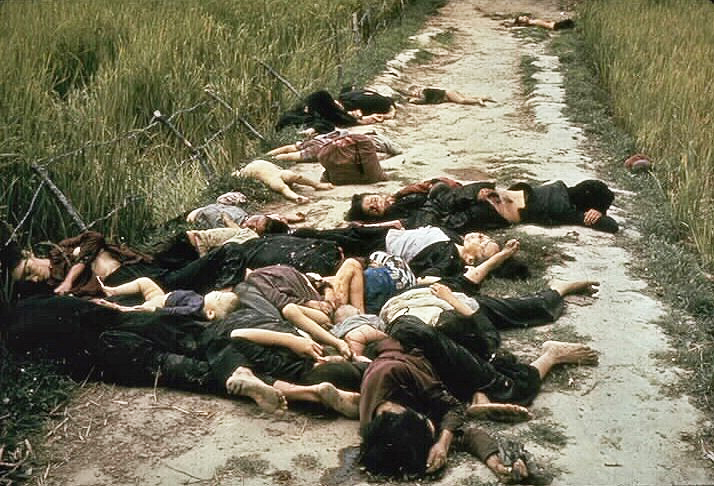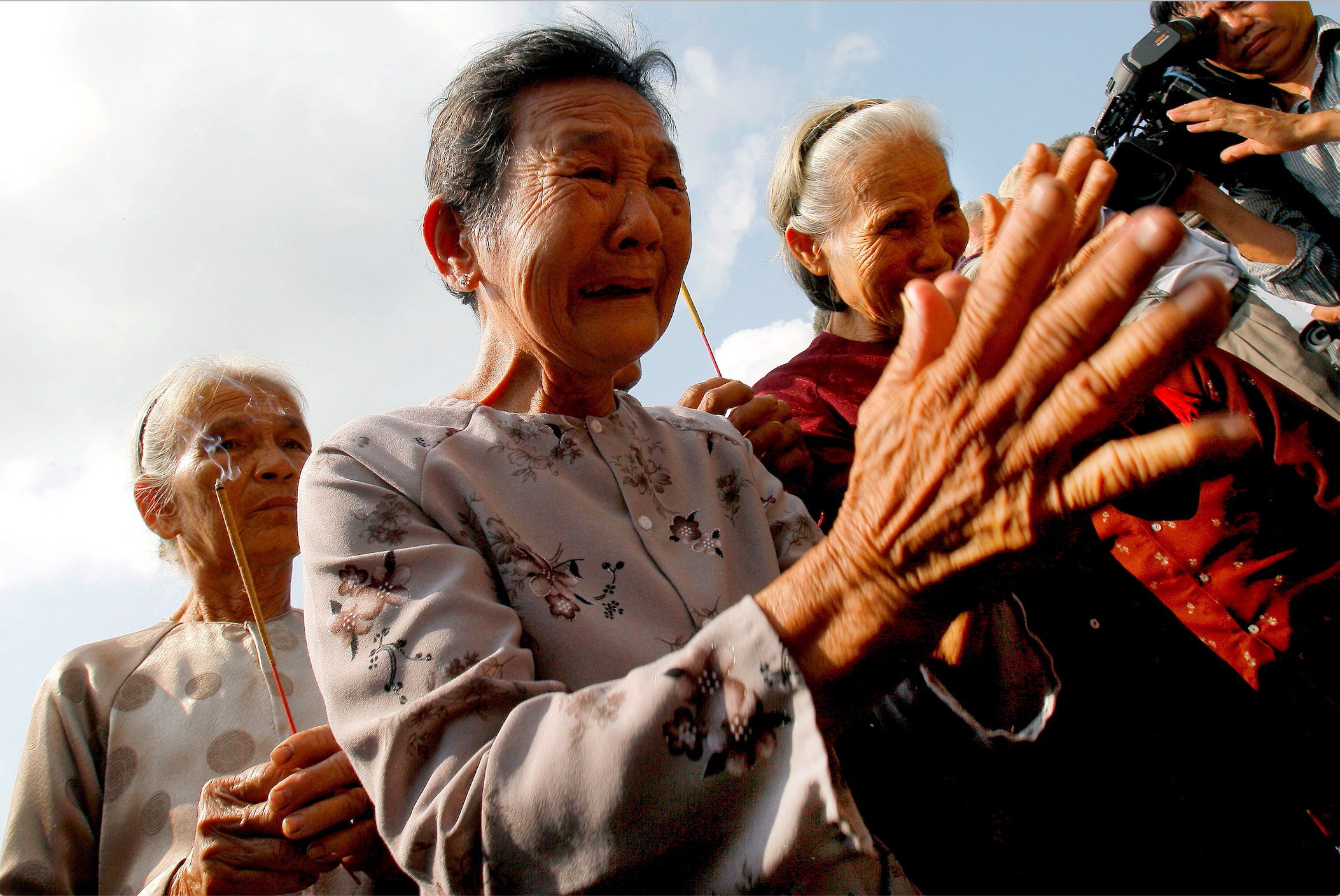Warning: Graphic images
On February 23, 1971, US Army Lieutenant William Calley began his second day of testimony in his court-martial, in which he stood accused of killing 109 unarmed civilians early in the morning of March 16, 1968, in the village Sơn Mỹ, mainly the hamlet of Mỹ Lai, in Quảng Ngãi province, South Vietnam.
On the stand, Calley dropped a bombshell, placing responsibility for what by then was known as the “Mỹ Lai Massacre” squarely on his superior officer, Captain Ernest Medina. Medina had commanded Company C, 1st Battalion, 20th Infantry Regiment, of the 11th Infantry Brigade, troops from which on March 16, 1968, killed in cold blood at least 347, but as many as 504, unarmed civilians in and around the village of Sơn Mỹ.
Calley’s court-martial, one of the longest in American history, began on November 17, 1970, at Fort Benning, Georgia. Now entering the trial’s fourth month, the leader of Calley’s disjointed defence team, former Utah Supreme Court Justice William Latimer, put Calley on the stand. Nervously, Calley explained how in the Army he learned to follow orders, that he could not recall instruction in the Geneva Conventions, and, astonishingly, that he did not know a subordinate officer could question an “unlawful order”.
Latimer then guided Calley through the events of March 15-16, 1968. Calley testified that Medina, in his pre-operation briefing on March 15, claimed the 48th Viet Cong Local Force battalion was in Sơn Mỹ and that local villagers would be “away at market”. Calley believed this implied that “anyone left would be considered enemies.” Latimer asked “if that meant women and children?” Calley replied that Medina “meant everything, . . . we had political clearance to destroy everything.”
As they entered Sơn Mỹ that March morning, Medina, Calley claimed, radioed him to “to hurry up, to get my people moving and get rid of people I had there”. Some minutes later, Medina radioed again, “asking why I was disobeying orders”. Medina, Calley testified, told him to “waste the Vietnamese”. “That was my order, . . . That was the order of the day,” from Captain Ernest Medina.
I went into the area to destroy the enemy. . . . They were enemy. . . . It was a group of people that were the enemy, sir
Calley repeated that he was following Medina’s orders to “destroy the enemy”. Asked Latimer, “Did you ever form an intent, specifically or generally, in connection with that My Lai operation to waste any Vietnamese – man, woman, or child?” “No,” replied Calley, “I went into the area to destroy the enemy. . . . They were enemy. . . . It was a group of people that were the enemy, sir.”
Calley went further: “I felt then and I still do that I acted as I was directed, and I carried out the orders that I was given, and I do not feel wrong in doing so, sir.” Never mind that in the Manual for Courts-Martial, “following orders” was not – just as it was not in the Nuremberg Tribunals – a defence for committing any crime, but most assuredly was not for committing an atrocity.
Calley had clearly implicated Medina, who awaited his own trial, accused of murdering an unarmed woman and small child on March 16, 1968, as well as the premeditated murder of Vietnamese civilians killed by troops under his command. Because he awaited court-martial, the Army prohibited Medina from appearing as a witness for the prosecution in the Calley trial. However, as a witness called by panel (jury) members, trial judge Colonel Reid W. Kennedy ordered Medina to appear. Agreeing to do so without immunity, Medina and his attorney F. Lee Bailey embraced the opportunity to counter Calley’s allegation.
On March 10, 1971, Medina took the stand. He calmly denied ordering Calley to kill women and children or “get rid” of civilians at Sơn Mỹ. Medina revealed that he was asked during the March 15 pre-operation briefing about killing women and children. “No, you do not kill women and children,” Medina testified to his reply. “You must use common sense. If they have a weapon and are trying to engage you, then you can shoot back, but you must use common sense.”
Under questioning from Calley’s defence attorney George Latimer, Medina nonetheless admitted killings had occurred and that he failed to report a large group of dead civilians he saw as he made his way through Sơn Mỹ. The two-year statute of limitations for failing to report an unauthorised killing had expired, so Medina was no longer in jeopardy for that offence. When asked why he failed to report atrocities committed by troops under his command, Medina steadfastly replied that what happened that day was “a disgrace upon the Army uniform I am very proud to wear”.
“I also realised the repercussions it would have against the United States of America,” he continued, “. . . my family. . . [and] lastly, myself, sir.”
On March 29, 1971, Judge Kennedy read the panel’s guilty verdict against Lieutenant William Calley, and two days later, sentenced Calley to serve the rest of his life in prison.

Before his trial, Medina agreed to take a polygraph test in the presence of Army prosecutor Major William Eckhardt and his defence counsel, F. Lee Bailey, both of whom asked Medina several questions. At this time, polygraph tests were inadmissible in courts-martial, but anything the subject said during the test could be admissible. When asked if he ordered his troops to kill civilians in Sơn Mỹ, Medina replied truthfully, “No.”
In what was known as a “peak of tension” test, Medina was asked: “Did you know that your men were killing unarmed, unresisting noncombatants” at specific time intervals for March 15 through March 17, 1968. Medina gave a flat line until the interval for 0730-0900 hours of March 16, when the machine’s needle went, according to Eckhardt, “off the chart”. In Eckhardt’s opinion, Medina may not have ordered or even meant for the massacre to happen, but he knew it was happening and did nothing to stop the killing until 1000 hours when he issued the ceasefire order.
To Medina, his only crime was failing to report “unauthorised killings” per standard operation procedure, an offence for which he was now immune
Medina’s court-martial began on August 16, 1971, at Fort McPherson, Georgia. The Army’s case against Medina for killing the woman and the child was shaky. For the former, Bailey convincingly established doubt with Medina’s and other testimony that Medina, fearing a hidden hand-grenade, instinctively shot the woman as she made a sudden movement while lying wounded on the ground. In the latter, presiding judge Colonel Kenneth Howard dismissed the charge of killing the child when Gene Oliver, an enlisted man now out of the Army and exempt from prosecution, came forward to admit mistakenly killing the young boy.
Eckhardt’s best case against Medina rested on command responsibility, for which he had to show Medina had direct knowledge that his troops were killing civilians and failed to stop them. The Army’s Law of Land Warfare embraced the so-called Yamashita Standard, named for Japanese General Tomoyuki Yamashita, whom an Allied war crimes tribunal executed for atrocities committed by troops under his command in the Philippines during World War II. While Yamashita may not have ordered his troops to commit these crimes, he failed to act when he learned of them. The Law of Land Warfare held a commander responsible if he had knowledge that an atrocious act was about to be committed by troops under his command or knew of such acts and failed to take appropriate action.
Eckhardt had little room for error. He called over fifty witnesses to testify to Medina’s movements on the morning of March 16. None convincingly placed him within sight of the mass killings. Just as damaging, almost to a person these witnesses praised Medina as an able and competent combat officer.
Medina testified in his own defence for three hours on September 16, offering unflappable denials that he ordered the killings or knew of the masses of corpses along trails and in ditches, and, incredibly, denied realising the enormity of what happened that awful day until the story broke months later in the press.
As soon as he realised something was wrong on March 16, he took appropriate action by ordering a ceasefire. To Medina, his only crime was failing to report “unauthorised killings” per standard operation procedure, an offence for which he was now immune.

On September 22, 1971, Howard turned the case over to the panel members for consideration. They returned in less than an hour to acquit Medina on all remaining charges. Eckhardt seemed snake bit – unreliable witnesses, Howard’s procedural constraints, and Bailey outflanking him at almost every turn. The case, said journalist Mary McCarthy, who witnessed the trial, “simply had no merit”.
Medina – the son of a New Mexico ranch hand, who in 1956 enlisted in the Army right out of high school and became a “Mustang” officer from the enlisted ranks – commanded troops who committed the most horrendous American mass atrocity of the Vietnam War, and escaped any responsibility.
As for Calley, sentencing reviews from the convening authority to the Secretary of the Army ultimately reduced his sentence to ten years. At three years served, Calley could be paroled. While the Army and other courts denied Calley’s appeals and requests for clemency, on November 19, 1974, Calley, by then considered by “doves” a victim of an immoral war and by “hawks” a heroic killer of communists, was paroled and walked free. Of the dozens who were not charged but allegedly participated in the Sơn Mỹ killings, and of the thirteen officers and enlisted men the Army did charge, Calley was the only one convicted.
After leaving the Army, Calley married and worked for his new father-in-law’s jewelry store in Columbus, Georgia, near Fort Benning. On August 19, 2009, Calley spoke to the Columbus Kiwanis Club – the first and only time he publicly addressed his role in the Mỹ Lai Massacre:
“There is not a day that goes by that I do not feel remorse for what happened that day in Mỹ Lai. I feel remorse for the Vietnamese who were killed, for their families, for the American soldiers involved and their families. I am very sorry.”
Following Medina’s acquittal, a New York Times editorial on September 24, 1971, concluded that the not-guilty verdict raised “questions of the most fundamental character. If there was no command responsibility in this situation, if Captain Medina was indeed innocent, then the Army itself stands condemned. An army cannot function unless command authority and responsibility go hand‐in‐hand.”
In a 1988 interview with the Associated Press, Medina, who rarely spoke of Sơn Mỹ after leaving the Army at the conclusion of his trial, called the massacre a “horrendous thing”. “I have regrets for it,” said Medina, “but I have no guilt over it because I didn’t cause it.” Medina died in 2018, at the age of 81.
In his court-martial testimony, Calley maintained that he considered Medina a “very fine officer, and I respected him very much. He ran a good company, and I am now and always will be very proud to have served under his command.”
The tragedy that was the Vietnam War forever links Calley, Medina, and the Mỹ Lai Massacre.
William Thomas Allison, Ph.D., is a Professor of History at Georgia Southern University in the US and is the author of My Lai: An American Atrocity in the Vietnam War.


